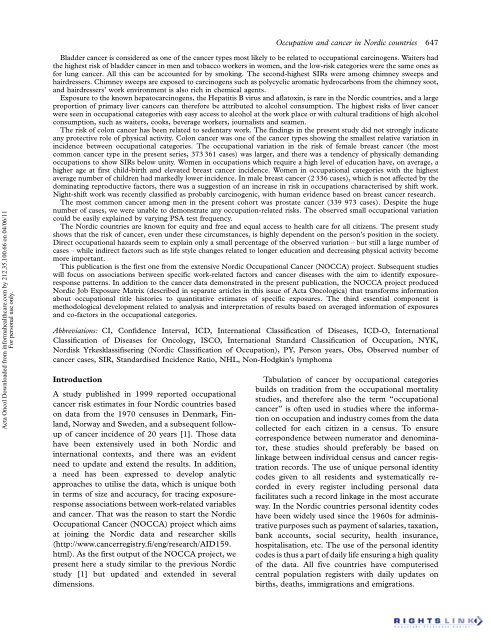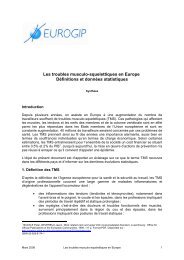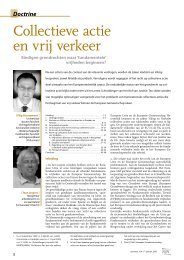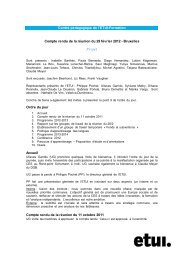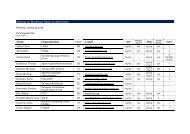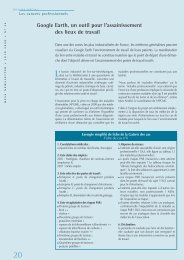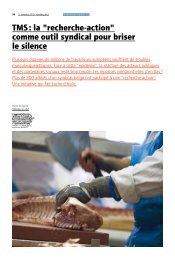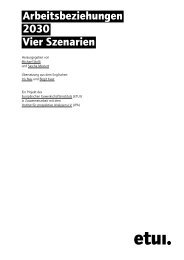Occupation and cancer - European Trade Union Institute (ETUI)
Occupation and cancer - European Trade Union Institute (ETUI)
Occupation and cancer - European Trade Union Institute (ETUI)
You also want an ePaper? Increase the reach of your titles
YUMPU automatically turns print PDFs into web optimized ePapers that Google loves.
Acta Oncol Downloaded from informahealthcare.com by 212.35.100.66 on 04/06/11<br />
For personal use only.<br />
Bladder <strong>cancer</strong> is considered as one of the <strong>cancer</strong> types most likely to be related to occupational carcinogens. Waiters had<br />
the highest risk of bladder <strong>cancer</strong> in men <strong>and</strong> tobacco workers in women, <strong>and</strong> the low-risk categories were the same ones as<br />
for lung <strong>cancer</strong>. All this can be accounted for by smoking. The second-highest SIRs were among chimney sweeps <strong>and</strong><br />
hairdressers. Chimney sweeps are exposed to carcinogens such as polycyclic aromatic hydrocarbons from the chimney soot,<br />
<strong>and</strong> hairdressers’ work environment is also rich in chemical agents.<br />
Exposure to the known hepatocarcinogens, the Hepatitis B virus <strong>and</strong> aflatoxin, is rare in the Nordic countries, <strong>and</strong> a large<br />
proportion of primary liver <strong>cancer</strong>s can therefore be attributed to alcohol consumption. The highest risks of liver <strong>cancer</strong><br />
were seen in occupational categories with easy access to alcohol at the work place or with cultural traditions of high alcohol<br />
consumption, such as waiters, cooks, beverage workers, journalists <strong>and</strong> seamen.<br />
The risk of colon <strong>cancer</strong> has been related to sedentary work. The findings in the present study did not strongly indicate<br />
any protective role of physical activity. Colon <strong>cancer</strong> was one of the <strong>cancer</strong> types showing the smallest relative variation in<br />
incidence between occupational categories. The occupational variation in the risk of female breast <strong>cancer</strong> (the most<br />
common <strong>cancer</strong> type in the present series, 373 361 cases) was larger, <strong>and</strong> there was a tendency of physically dem<strong>and</strong>ing<br />
occupations to show SIRs below unity. Women in occupations which require a high level of education have, on average, a<br />
higher age at first child-birth <strong>and</strong> elevated breast <strong>cancer</strong> incidence. Women in occupational categories with the highest<br />
average number of children had markedly lower incidence. In male breast <strong>cancer</strong> (2 336 cases), which is not affected by the<br />
dominating reproductive factors, there was a suggestion of an increase in risk in occupations characterised by shift work.<br />
Night-shift work was recently classified as probably carcinogenic, with human evidence based on breast <strong>cancer</strong> research.<br />
The most common <strong>cancer</strong> among men in the present cohort was prostate <strong>cancer</strong> (339 973 cases). Despite the huge<br />
number of cases, we were unable to demonstrate any occupation-related risks. The observed small occupational variation<br />
could be easily explained by varying PSA test frequency.<br />
The Nordic countries are known for equity <strong>and</strong> free <strong>and</strong> equal access to health care for all citizens. The present study<br />
shows that the risk of <strong>cancer</strong>, even under these circumstances, is highly dependent on the person’s position in the society.<br />
Direct occupational hazards seem to explain only a small percentage of the observed variation but still a large number of<br />
cases while indirect factors such as life style changes related to longer education <strong>and</strong> decreasing physical activity become<br />
more important.<br />
This publication is the first one from the extensive Nordic <strong>Occupation</strong>al Cancer (NOCCA) project. Subsequent studies<br />
will focus on associations between specific work-related factors <strong>and</strong> <strong>cancer</strong> diseases with the aim to identify exposureresponse<br />
patterns. In addition to the <strong>cancer</strong> data demonstrated in the present publication, the NOCCA project produced<br />
Nordic Job Exposure Matrix (described in separate articles in this issue of Acta Oncologica) that transforms information<br />
about occupational title histories to quantitative estimates of specific exposures. The third essential component is<br />
methodological development related to analysis <strong>and</strong> interpretation of results based on averaged information of exposures<br />
<strong>and</strong> co-factors in the occupational categories.<br />
Abbreviations: CI, Confidence Interval, ICD, International Classification of Diseases, ICD-O, International<br />
Classification of Diseases for Oncology, ISCO, International St<strong>and</strong>ard Classification of <strong>Occupation</strong>, NYK,<br />
Nordisk Yrkesklassifisering (Nordic Classification of <strong>Occupation</strong>), PY, Person years, Obs, Observed number of<br />
<strong>cancer</strong> cases, SIR, St<strong>and</strong>ardised Incidence Ratio, NHL, Non-Hodgkin’s lymphoma<br />
Introduction<br />
A study published in 1999 reported occupational<br />
<strong>cancer</strong> risk estimates in four Nordic countries based<br />
on data from the 1970 censuses in Denmark, Finl<strong>and</strong>,<br />
Norway <strong>and</strong> Sweden, <strong>and</strong> a subsequent followup<br />
of <strong>cancer</strong> incidence of 20 years [1]. Those data<br />
have been extensively used in both Nordic <strong>and</strong><br />
international contexts, <strong>and</strong> there was an evident<br />
need to update <strong>and</strong> extend the results. In addition,<br />
a need has been expressed to develop analytic<br />
approaches to utilise the data, which is unique both<br />
in terms of size <strong>and</strong> accuracy, for tracing exposureresponse<br />
associations between work-related variables<br />
<strong>and</strong> <strong>cancer</strong>. That was the reason to start the Nordic<br />
<strong>Occupation</strong>al Cancer (NOCCA) project which aims<br />
at joining the Nordic data <strong>and</strong> researcher skills<br />
(http://www.<strong>cancer</strong>registry.fi/eng/research/AID159.<br />
html). As the first output of the NOCCA project, we<br />
present here a study similar to the previous Nordic<br />
study [1] but updated <strong>and</strong> extended in several<br />
dimensions.<br />
<strong>Occupation</strong> <strong>and</strong> <strong>cancer</strong> in Nordic countries 647<br />
Tabulation of <strong>cancer</strong> by occupational categories<br />
builds on tradition from the occupational mortality<br />
studies, <strong>and</strong> therefore also the term ‘‘occupational<br />
<strong>cancer</strong>’’ is often used in studies where the information<br />
on occupation <strong>and</strong> industry comes from the data<br />
collected for each citizen in a census. To ensure<br />
correspondence between numerator <strong>and</strong> denominator,<br />
these studies should preferably be based on<br />
linkage between individual census <strong>and</strong> <strong>cancer</strong> registration<br />
records. The use of unique personal identity<br />
codes given to all residents <strong>and</strong> systematically recorded<br />
in every register including personal data<br />
facilitates such a record linkage in the most accurate<br />
way. In the Nordic countries personal identity codes<br />
have been widely used since the 1960s for administrative<br />
purposes such as payment of salaries, taxation,<br />
bank accounts, social security, health insurance,<br />
hospitalisation, etc. The use of the personal identity<br />
codes is thus a part of daily life ensuring a high quality<br />
of the data. All five countries have computerised<br />
central population registers with daily updates on<br />
births, deaths, immigrations <strong>and</strong> emigrations.


